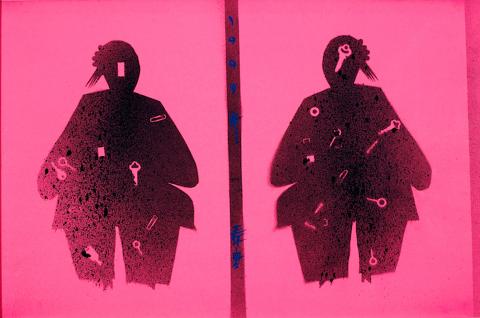First Exit Existence I (真實的存在 I), an exhibition of work by Tsui Yung-yen (崔永嬿) and Tsui Hui-yu (崔惠宇), kicks off a three-part series of sculpture shows at Aki Gallery that runs until the end of July. Tsui Yung-yen’s realist sculptures depict characters from fairy tales that question the role of women in contemporary society. Tsui Hui-yu’s large-scale sculptures made from dyed fabric look like abstract tapestries.
■ Aki Gallery (也趣藝廊), 141 Minzu W Rd, Taipei City (台北市民族西路141號), tel: (02) 2599-1171. Open Tuesdays to Sundays from noon to 6:30pm
■ Opening reception on Saturday at 3pm. Until June 10

Photo courtesy of Soka Art Center
Vision (索卡視界) is a wide-ranging exhibition of painting from Taiwan and China and covers the major artistic styles of the genre in the 20th century, including landscapes by Lin Fengmian (林風眠), abstract expressionist works by Zao Wou-ki (趙無極) and Chu Teh-chun (朱德群) and conceptual works by Cai Guoqiang (蔡國強) and Xu Bing (徐冰), who draw on traditional materials to examine contemporary themes.
■ Soka Art Center (索卡藝術中心), 2F, 57, Dunhua S Rd Sec 1, Taipei City (台北市敦化南路一段57號2樓), tel: (02) 2570-0390. Open Tuesdays to Sundays from 11am to 9pm
■ Until July 1
Jade, agate, sandstone, granite and marble are among the many materials Chen Pei-tse (陳培澤) uses to create sculptures that riff off Neolithic carvings. But Sharpening the Sense of Life (如切如磋。斯土斯懷) isn’t simply a retrospective of 30 works with its gaze fixed on the distant past. Chen also incorporates technology into his work, the forms of which show his “rethinking of nature and culture,” according to the museum’s press release.
■ National Museum of History (國立歷史博物館), 49 Nanhai Rd, Taipei City (台北市南海路49號), tel: (02) 2361-0270. Open Tuesdays to Sundays from 10am to 6pm. General admission: NT$30
■ Until June 24
The Museum of Contemporary Art, Taipei, is currently displaying the short-listed works for this year’s Taishin Arts Award (台新藝術獎), an annual competition that gives out over NT$1 million in prize money. This year’s exhibit includes documentaries, photos and films of 10 performance group finalists, including Ju Percussion Group (朱宗慶打擊樂團) and Riverbed Theater (河床劇團), and five pieces of visual art, including Tsai Ming-liang’s (蔡明亮) video Theater in the Boiler (鍋爐裡的劇場), Yao Jui-chung’s (姚瑞中) Mirage (海市蜃樓—台灣閒置公共設施攝影計劃) and Wu Dar-kuen’s (吳達坤) After the Republic of China — Nobody’s Republic (後民國—沒人共和國).
■ Museum of Contemporary Art, Taipei, (台北當代藝術館), 39 Changan W Rd, Taipei City (台北市長安西路39號), tel: (02) 2552-3721. Open daily from 10am to 6pm, closed on Mondays. Admission: NT$50
■ Until June 17
Embracing Fantasy (藝想天開) is an exhibition of contemporary ceramics by 15 Taiwanese artists and nine from the US, Japan, Holland, Switzerland, Belgium, France and New Zealand. Chen Ching-jung (陳景容), Lee Chin-sheng (李金生) and Chris Weaver focus on the expression of emotions that are a product of their own life experiences, while Wu Chien-fu (吳建福) and Deborah Sigel use ceramics to give voice to their concerns about the environment. Angela Burkhardt-Guallini, Jean-Francois Fouilhoux and Chen Shih-han (陳實涵) take traditional techniques as their starting point, but introduce innovations and new breakthroughs. Taken together, the exhibition demonstrates the variety of shapes, styles, glazes and techniques embraced by contemporary ceramic artists across the globe.
■ Yingge Ceramics Museum (鶯歌陶瓷博物館), 200 Wenhua Rd, Yingge Dist, New Taipei City (新北市鶯歌區文化路200號), tel: (02) 8677-2727. Open daily from 9:30am to 5pm. Closes at 6pm on Saturdays and Sundays
■ Until July 1

In the March 9 edition of the Taipei Times a piece by Ninon Godefroy ran with the headine “The quiet, gentle rhythm of Taiwan.” It started with the line “Taiwan is a small, humble place. There is no Eiffel Tower, no pyramids — no singular attraction that draws the world’s attention.” I laughed out loud at that. This was out of no disrespect for the author or the piece, which made some interesting analogies and good points about how both Din Tai Fung’s and Taiwan Semiconductor Manufacturing Co’s (TSMC, 台積電) meticulous attention to detail and quality are not quite up to

April 21 to April 27 Hsieh Er’s (謝娥) political fortunes were rising fast after she got out of jail and joined the Chinese Nationalist Party (KMT) in December 1945. Not only did she hold key positions in various committees, she was elected the only woman on the Taipei City Council and headed to Nanjing in 1946 as the sole Taiwanese female representative to the National Constituent Assembly. With the support of first lady Soong May-ling (宋美齡), she started the Taipei Women’s Association and Taiwan Provincial Women’s Association, where she

Chinese Nationalist Party (KMT) Chairman Eric Chu (朱立倫) hatched a bold plan to charge forward and seize the initiative when he held a protest in front of the Taipei City Prosecutors’ Office. Though risky, because illegal, its success would help tackle at least six problems facing both himself and the KMT. What he did not see coming was Taipei Mayor Chiang Wan-an (將萬安) tripping him up out of the gate. In spite of Chu being the most consequential and successful KMT chairman since the early 2010s — arguably saving the party from financial ruin and restoring its electoral viability —

It is one of the more remarkable facts of Taiwan history that it was never occupied or claimed by any of the numerous kingdoms of southern China — Han or otherwise — that lay just across the water from it. None of their brilliant ministers ever discovered that Taiwan was a “core interest” of the state whose annexation was “inevitable.” As Paul Kua notes in an excellent monograph laying out how the Portuguese gave Taiwan the name “Formosa,” the first Europeans to express an interest in occupying Taiwan were the Spanish. Tonio Andrade in his seminal work, How Taiwan Became Chinese,